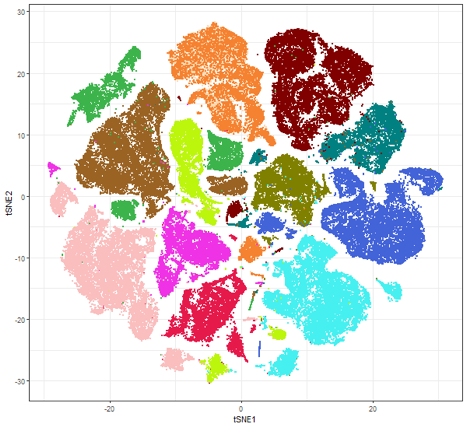Data analysis
As we have more than 40 parameters to analyze, manual data analysis is not sufficient for a thorough exploration of a multiplex-mass cytometry data set. Here, we use computational tools to perform dimensionality reduction (PCA, t-SNE, UMAP), clustering (SPADE, FlowSOM, Phenograph), feature comparison (CITRUS) etc.

We recommend getting in touch with a data analyst already in the planning phase of your experiments to ensure that the data you generate is of sufficient quality and all necessary controls are measured. At present, the IMC platform is not able to provide the service of data analysis but will assist you in finding a solution.
Data Preprocessing
After acquisition on the Helios, the user is responsible for panel editing, concatenation, normalization (with EQ beads) and debarcoding. If the user would like this done as a service, the IMC Platform team can do this for the price of a half hour consultation. The IMC Platform employs the R algorithm Premessa to perform these tasks and highly recommends it to users as well. We cover this topic and how to clean up your data in the Introduction to Helios course (see Training for more details).
Data analysis companies
Astrolabe Diagnostics
A company offering full CyTOF data analysis for users with no analysis experience or informatics support.
https://astrolabediagnostics.com/
Automated single-cell analysis and reporting
Maxpar Pathsetter for CyTOF data from Fluidigm
Maxpar® Pathsetter™ (https://www.fluidigm.com/singlearticles/pathsetter) is a fully automated reporting and data analysis solution that automatically identifies 37 immune cell types in FCS files from samples processed with the Maxpar Direct™ Immune Profiling System (MDIP kit). It is important to note that this pipeline only works for this kit.
Here you can find an approach to perform data analysis using Pathsetter.
Data analysis of Maxpar Direct Immune Profiling assay with Pathsetter (PDF, 1.5 MB)
Data analysis program
FlowJo
FlowJo, a standard tool used for flow cytometry data analysis, is currently expanding into mass cytometry data analysis. FlowJo offers dimensionality reduction (via t-SNE) in the base package, and the new Plug-in system allows users to utilize a small suite of packages such as FlowSOM, Phenograph and flowClean to analyze high dimensional data.
Data analysis cloud-based programs for Helios
OMIQ
Motto:Single cell analysis made simple. It is a cloud-based program capable of performing all stages of CyTOF data analysis.
*Please let the IMC Platform team know if you are interested in getting a discounted yearly OMIQ license through our platform.
Cytobank
Cytobank is a web-based software solution that provides t-SNE dimensionality reduction and FlowSOM, SPADE and CITRUS for clustering analysis.
Analysis with a programming language
R and Python
R is a programming language with a strong focus on statistics that has become a favorite platform for mass cytometry analysis. It’s relatively easy to learn and provides the greatest power and flexibility to analyze mass cytometry data through the packages developed to handle mass cytometry data.
The following is an example of a published R-based mass cytometry analysis pipeline
